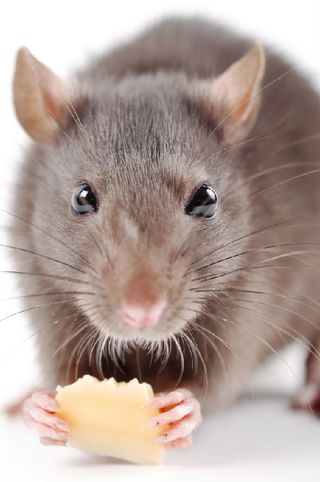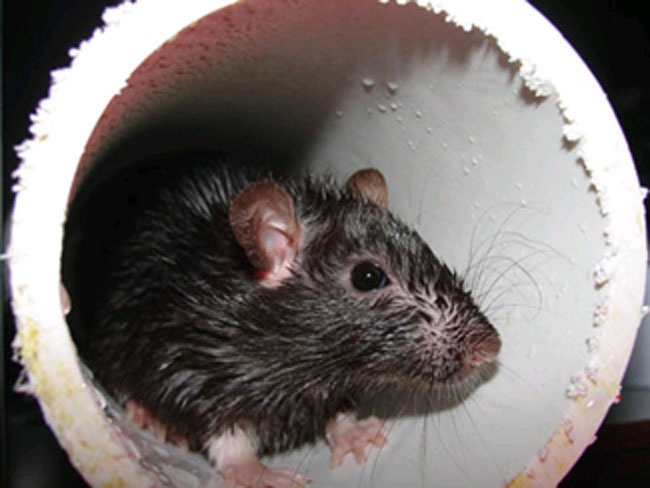Easy a Who Gives a Rats Ass
Facts About Rats

Rats are thin-tailed, medium-size rodents that originated in Asia and Australia but are now found all over the world. "True rats" are members of the genusRattus, but other rodent genera are also referred to as rats and share many of the same characteristics. Rats differentiate from mice by being larger, with longer, thinner bodies and long legs.
Size
According to the Integrated Taxonomic Information System (ITIS) there are more than 60 species of rat, which means they come in all sizes. They are typically 5 inches (12 centimeters), or longer, according to Encyclopedia Britannica. The largest species is the Bosavi woolly rat, which was discovered in 2009 in the rainforest of Papua New Guinea (and doesn't have a scientific name yet). It is about the size of a cat — 32.2 inches (82 cm) from nose to tail and weighs around 3.3 lbs. (1.5 kilograms), according to CNN. One of the smallest rats is Osgood's Vietnamese rat. It is typically 5 to 7 inches (12 to 17 cm) long.
According to the Australian Broadcasting Corp., male rats are called bucks; females are does. Infants are called pups or kittens. A group of rats is called a mischief.
Habitat
Rats are found all over the world. For example, the rice-field rat is found in Southeast Asia, the Australian swamp rat is found in Eastern Australia, and the Norway rat, also called brown rats, is found on every continent of the world except Antarctica, according to the Animal Diversity Web at the University of Michigan.
The brown and the house rat are the most common rats in the world because they have taken boats to every country over the past few centuries. House rats typically like warmer climates, while brown rats live in temperate climates. They typically live anywhere humans live. Many rat species also live in trees.
Habits
Overall, rats live to forage and mate. Most rats are nocturnal, though the brown rat is often awake day or night.
Rats usually stick together in groups called packs. New packs are formed when a male and female go off on their own and nest in an area that doesn't already contain a pack. Brown rats are usually led by the largest male in the pack. Other rats may have several dominant males or females in a pack.

Diet
Rats are omnivores, but many prefer meat when they can get it. House and brown rats usually use humans for their primary food source. They will scavenge through trash or eat any food that is left unprotected.
Rats have also been known to eat grain or kill insects, water creatures such as snails, fish and mussels, small birds, mammals and reptiles for food. Other rats, such as the Sulawesi white-tailed rat and Hoffman's rat, prefer vegetarian fair such as seed and fruits, according to Encyclopedia Britannica.
Offspring
Before their offspring are born, rats build nests from any material that can be foraged from the area, including branches, grass, trash and paper. These nests are usually built in crevices, in rotting trees or in buildings.
Rats, generally, are baby-making machines. Female rats can mate around 500 times in a six-hour period and brown rats can produce up to 2,000 offspring in a year, according to Discover Magazine. Brown rats can have up to 22 young at once, though eight or nine is more the average. Tropical rats tend to only have one to six babies at once.
After a gestation period of 21 to 26 days, babies that weigh only around 6 to 8 grams (.21 to .28 ounces) are born, according to the American Fancy Rat and Mouse Association. By the age of three months, the brown rat is ready to reproduce. Rats typically live around two or three years. Most house rats — 91 to 97 percent — die within their first year of life, according to the University of Michigan.
Classification/taxonomy
Here is the taxonomy of rats according to ITIS:
- Kingdom: Animalia
- Subkingdom: Bilateria
- Infrakingdom: Deuterostomia
- Phylum: Chordata
- Subphylum: Vertebrata
- Infraphylum: Gnathostomata
- Superclass: Tetrapoda
- Class: Mammalia
- Subclass: Theria
- Infraclass: Eutheria
- Order: Rodentia
- Suborder: Myomorpha
- Superfamily: Muroidea
- Family: Muridae
- Subfamily: Murinae
- Genus:Rattus
Species include:
- Rattus argentiventer— Rice-field rat
- Rattus hoffmanni— Hoffmann's Sulawesi rat
- Rattus lutreolus— Australian swamp rat
- Rattus norvegicus— Norway rat, or brown rat
- Rattus osgoodi— Osgood's Vietnamese rat
- Rattus rattus— House rat, or black rat
- Rattus xanthurus— Northeastern Xanthurus rat, or Sulawesi white-tailed rat
Conservation status
The International Union for Conservation of Nature (IUCN) lists 16 rat species on its Red List of Threatened Species. They are considered threatened with extinction due to loss of habitat and decreasing populations.
Near Threatened
- Rattus elaphinus (Sula Archipelago rat)
- Rattus feliceus (Spiny Seram Island rat)
- Rattus jobiensis (Yapen rat)
Vulnerable
- Rattus hoogerwerfi (Hoogerwerf's Sumatran rat)
- Rattus palmarum (Zelebor's Nicobar rat)
- Rattus richardsoni (Glacier rat)
- Rattus satarae (Sahyadris forest rat)
- Rattus stoicus (Andaman rat)
- Rattus xanthurus (Northeastern Xanthurus rat)
Endangered
- Rattus burrus (Miller's Nicobar rat)
- Rattus hainaldi (Hainald's Flores Island rat)
- Rattus lugens (Mentawai Archipelago rat)
- Rattus montanus (Sri Lankan mountain rat)
- Rattus ranjiniae (Ranjini's field rat)
- Rattus simalurensis (Simalur Archipelago rat)
- Rattus vandeuseni (Van Deusen's rat)
Other facts
Brown and house rats have made a number of mammal, bird and reptile species extinct, especially on oceanic islands, according to Encyclopedia Britannica. They have also spread of diseases among humans, including bubonic plague.
Rats aren't all bad, though. Brown rats are used in laboratories for research. In fact, according to the Foundation for Biomedical Research, 95 percent of all lab animals are mice and rats.
A rat's front teeth grow 4.5 to 5.5 in (11 to 14 cm) each year, according to Discover Magazine.
Additional resources
- Discover Magazine: 20 Things You Didn't Know About Rats
- Internet Center for Wildlife Damage and Management: Norway Rats
- US Fish and Wildlife Service: Facts About Rats
Source: https://www.livescience.com/52342-rats.html